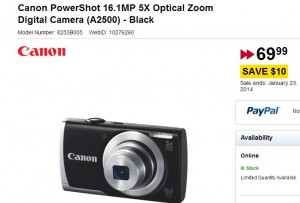In our last post we told you why cell phone cameras won’t replace standalone digital cameras. Here’s the link in case you missed it: Cell Phones Won’t Replace Cameras There is a theory out there that people use their mobile devices instead of digital cameras because they’re easier to operate. While that may be true for some people, we think our readers are a little smarter than most. Today we’re going to explain some of the basic specifications of an inexpensive point and shoot camera. The term point and shoot may put some purists off but, believe us, any of today’s bottom line cameras take excellent photos, often on a par with yesterday’s SLRs. Here we go:
The Basics:
1. Point and shoot simply means a camera with a fixed, as opposed to removable, lens.
2. An SLR, now a DSLR, describers a ‘digital single lens reflex’ camera which has the ability to accept different lenses. Specs on these will be in a future post.
3. Because a point and shoot will only ever have one lens, they are made with a lens that has the ability to cover a wide point of view, as well as the ability to zoom in for closeups. More on this later.
4. Most point and shoot cameras come with a tiny amount of internal storage, something that will hold maybe one or two photos. This means you must use some form of flash card to store your photos until you can transfer them to your computer. The standard form these days is an SD card, sometimes referred to as an SDHC (high capacity) card. Sizes vary but we’d suggest a minimum of eight gigabytes. We’d also suggest buying multiple smaller cards rather than one big card. If a flash card screws up, better to have another one that you can use instead of having nothing to use until you get to a store.

Complications that aren’t really that complicated:
1. Megapixels. The first number in a camera’s description is always its megapixels. This one is 12MP, that one is 18MP. Please ignore this number, at least as far as using it to decide on a camera. In this case, more is not necessarily better and, unless you are going to print your photos, megapixels are almost totally irrelevant. Here’s a comparison for you. The older digital cameras might have been able to take a photo that you could print up at 4×5 inches, some might have been able to print at 5×7 inches. That’s the size most people use.
Today’s cameras can take a photo that will result in a print that’s the size of a wall. This is great if you’re going to post your pics all over your house, one per wall, but who does that? Megapixels relate to the size of a printed photo, in other words. Since most of us view photos on our computers, those wall size photos are scaled down anyway. The full size photo won’t fit on even the largest monitors without scrolling left to right and top to bottom.
TIP: Large megapixel cameras allow you to zoom in when the photo is being viewed on your computer without distortion. This is the only benefit to the enormous megapixel ratings out there. Let’s say you take a photo of a group of people. If you have enough megapixels, you can zoom in on one person in the photo, crop it so we only see them and the result will look as good as if you zoomed in with your camera instead of editing software. Many photographers crop their photos in post-production, removing anything on the periphery of what they want the subject to be. With enough megapixels, you’d never see the difference.
2. Optical zoom/digital zoom – Only one of these is good, that being optical zoom. Optical refers to the lens itself. When you use optical zoom, you are adjusting the pieces of the lens in relation to each other which allows you to make your point of view smaller but making part of it larger. You zoom in using the lens itself, in other words. A 5X optical zoom means that you will move five times closer to the subject at full zoom. Of course you can select anything in between in order to compose your photo.
Digital zoom means that you are zooming in using the electronics in the camera, no different than enlarging a photo on your computer. You aren’t really getting closer to the action, you’re just making the image larger. This type of zoom if useless, in our opinion. The problem is distortion. View any photo on your computer then hold the control key down and roll up with your mouse button. The image will get bigger. Note the amount of distortion that you see as you zoom in .
Enough reading for today. Those are the basics. In our next post we will get into more specs, things like focal length and 35mm equivalent. Stay tuned! Thanks for reading.
Why not Like us on our Facebook page? Here is the link: Computers Made Simple on Facebook We’ll be glad you did.
________________________________________________
Here’s a link that might help us if you are interested in hosting your own blog with Fatcow Hosting. We’ve signed up to become an affiliate and we make a bit of money if you sign up for hosting via this link: FatCow Hosting Thanks!

One thought on “Basic Point-and-Shoot Specs”